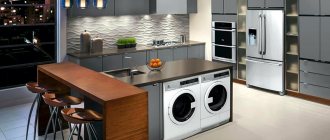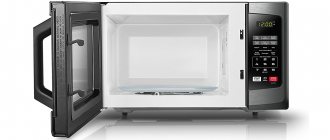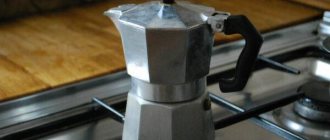Premium built-in appliances combine high functionality with the ability to optimally fit the device into the kitchen interior and save space. Built-in microwave ovens have long made it possible not only to heat up food, but also to cook chicken or meat with a golden brown crust, or bake a pie or cupcake.
The microwave is not a very large unit; it fits well into a kitchen cabinet, into a hanging cabinet, or into a niche. Modern production of microwave ovens focuses specifically on built-in models - their choice is very large.
In addition to the usual solo ovens that cook using microwaves, the Hausdorf online store offers devices with a grill, convection, pizza baking function and quick defrosting of food. We offer customers models with electronic and mechanical control systems, in modern and classic styles, in a variety of colors, finished in bronze, steel, and brass. The design of built-in models does not have legs for height adjustment, and the facade can be decorative or open.
What sizes are built-in microwave ovens?
What sizes are built-in microwave ovens?
What sizes are built-in microwave ovens?
Manufacturers choose the standard dimensions of a built-in microwave oven based on the dimensions of the kitchen furniture.
Kinds
Depending on the functionality and available modes, there are several types of built-in microwaves:
- Solo. They perform only basic functions - heating and defrosting food, preparing simple dishes.
- Ovens with grill. The grill can be top or bottom. In some models, the shadow moves by 45 degrees if necessary.
- Devices with grill and convection. In addition to the heating element, there is a fan that evenly distributes warm air.
- Multifunctional ovens, in addition to the main modes, allow you to steam food
Device types
Microwave ovens come in different types:
- Solo. This is a classic option. The functionality is sparse, but includes everything you need. Used to heat food. Their advantage is compactness. They will fit comfortably in a small kitchen: on a table, windowsill or hanging trenches.
- Convection. The functionality here is wider. This is convection, grill with other automatic modes. Moreover, the equipment can be both medium and large. Small convection microwaves are rare.
- Inverter. There is a special mechanism inside the chamber that increases and decreases the power. Heating and cooking food occurs faster than in other microwave ovens.
Methods of heating food
Stay up to date! Food can be heated in a microwave oven in several ways:
- microwaves - do not create a crispy crust, but are suitable for heating or defrosting food;
- grill - a heating element, the heat from which gradually spreads throughout the entire working chamber;
- convection - replaces the oven.
When you turn on the combination mode, convection and microwaves are activated simultaneously.
This allows you to get a tender product with a crispy crust and at the same time reduce its cooking time.
How useful is sizing information?
Knowing the size, it will be much more convenient to choose a microwave in the store. This information will help narrow your search to a minimum. This will also help you choose functionality. If we are talking about mini-appliances, then you should not rely on convection and grilling in them. The parts simply won't fit into the device.
Parameters that you should pay attention to when choosing
To use the device truly comfortably, you need to study the principle of its installation and operation, and check whether all the necessary components are included.
Control system
The oven may use rotary mechanical, rotary tact, push-button or touch switches .
Mechanical control is considered the most reliable and insensitive to power outages.
Experts do not recommend purchasing models with touch buttons if you plan to use the oven exclusively for heating food.
Embedding rules
Keep in mind! It must be taken into account that there should be 2-3 cm of free space in the niche on the side, top and back of the device.
The grill and convection oven may become hot, so keep the appliance away from surfaces that could be affected by heat and hot steam.
Equipment
comes complete with a glass dish, a coupling that rotates it, instructions, a warranty card and a cable for connecting the device to the network.
Grill and convection appliances usually come with two grates on stands: high and low.
If the oven supports the steaming function, a special container should be included with it.
Some manufacturers include plastic containers for storing and heating food.
They can also provide a special dish for creating a crispy crust, a lid to prevent fat from splashing, etc.
Culinary functionality
Microwave ovens have different feature sets, so before purchasing, it is important to check whether the appliance's features meet your expectations.
Door
You should know! The door can be hinged with side hinges or hinged with hinges at the bottom.
Depending on the model, it opens with a handle or by pressing a button.
Power and energy efficiency
Power affects the speed of cooking. For different models it can vary from 600 to 1200 W.
This setting can be adjusted depending on the type of product.
When purchasing a microwave oven, you need to balance its energy efficiency with the capabilities of your wiring .
The simplest microwave consumes from 0.5 to 1.5 kW, with a grill - from 1.5 to 2.8 kW, with grill and convection - from 2 to 3 kW.
The characteristics of the device must indicate the energy efficiency class. The most economical: A, A+, A++, B and C.
Note! Household appliances waste electricity not only during operation, but also during standby mode.
To reduce costs, you need to turn off the device from the network.
Security questions
Your microwave oven may have a safety device built into it to prevent children from accidentally turning it on .
When this function is activated, the device cannot be used until the lock is removed.
Design
The microwave oven should fit harmoniously into the interior of the kitchen.
When choosing a built-in model, it is worth considering that only the front side of the device will be visible.
Inner coating
The walls of the working chamber of a microwave oven can be covered with ceramics, enamel, stainless steel or bioceramic enamel.
The most commonly used coating is enamel . It is wear-resistant and easy to clean.
But enamel cannot be exposed to high temperatures, so this material is not suitable for models with oven functions.
The ceramic and bioceramic coating
For your information! There is practically no accumulation of soot on it and no scratches appear, and food particles and splashes of grease are easily washed off.
Stainless steel looks aesthetically pleasing and can withstand any temperature , but this material is more difficult to maintain.
Burnt fat is difficult to remove, and if you use abrasives, scratches will remain.
To simplify the process of caring for stainless steel, it is recommended to cover the plates with special lids.
Standard dimensions of microwave ovens
Microwaves are divided into two categories based on housing type:
- Freestanding or stationary. They can be compact or full-size. They can be placed anywhere in the kitchen as they do not take up much space.
- Built-in. They have large dimensions. The advantage of these microwaves is their wide functionality. The design will not take up much space if you insert it into a kitchen set. This will solve the problem, and the built-in microwave will have only advantages.
Freestanding
These microwave ovens have the following standards (in cm):
- depth - 40;
- height - 30;
- width - up to 50.
The turntable comes in different diameters. It ranges from 24 to 27 cm.
Built-in
Built-in microwave ovens for the kitchen differ in the following parameters (in cm):
- height - 30;
- depth - 30-60;
- width - 45.
Additional functionality worth paying attention to
When choosing a device, you should pay attention to whether it supports the following functions:
- Defrosting – mode for thawing food.
- Automatic defrosting is a mode in which you need to select the product category and its weight, but there is no need to select time and power.
- Delay start – programming the time for turning on the gadget. This feature is useful for busy people. You can put the dish in the oven in advance and it will heat or prepare it for you when you arrive.
- Automatic cooking - classic recipes stored in the device's memory. It is enough to prepare the products in accordance with the instructions, place them in the working chamber and press the appropriate button. The oven itself will select the optimal temperature, power and time.
- Convection. Necessary if you plan to cook baked goods.
- Grill. Allows you to cook foods with a crispy crust. The grill can be presented in the form of a closed quartz element or ten. The first option makes cleaning the cooking chamber easier because food particles do not fall on it. But ten copes with its functions better.
- Automatic heating – one or several modes of heating a dish with a preset power and time.
- Turning off the sound signal – silent operation mode. Important for those who do not want to disturb family members with the loud sounds that the stove makes after finishing work.
Installation Rules
There are no big problems with installing this device in the kitchen, which makes choosing a microwave very much easier. It requires a power source, there is no need to install a separate power line (unless these are models with large dimensions), or make a gas supply. The location of the device itself raises more questions.
Not every device can be built into a niche. It depends on the ventilation device. If you place it on the wrong side of the wall, the air will not flow correctly and the unit will overheat and fail. For the same reason, you cannot cover the device.
It is strictly forbidden to place flowers on it, because the microwave creates a magnetic field that can harm them. The proximity to the equipment must be correct. You should not place a laptop on top - there is a risk of overheating of both objects.
The most advantageous placement, selected according to size, would be a hanging shelf or a separate place on the countertop. You can put it on the windowsill, but will it be convenient to open the window? During ventilation mode, when it rains, water may flow inside and cause a short circuit.
When selecting a microwave, you need to know exactly the height, width and depth of the device so that you can correctly position it on the work surface.
Top companies of built-in microwave ovens:
Samsung
- Samsung FW77SUW;
- Samsung FW87SUT;
- Samsung MG22M8054AK;
- Samsung FW77SUB;
- Samsung FG77SUT.
Hansa
- Hansa AMG20BFH;
- Hansa AMM20BMXH;
- Hansa AMM20BEXH;
- Hansa AMM20BESH;
- Hansa AMM20BEIH.
Siemens
- Siemens BF525LMS0;
- Siemens BF525LMW0;
- Siemens BF634LGS1;
- Siemens BF525LMW0;
- Siemens BF634LGS1.
Kuppersberg
- Kuppersberg HMW 655 X;
- Kuppersberg HMW 650 W;
- Kuppersberg HMW 650 BX;
- Kuppersberg HMW 655 W;
- Kuppersberg HMW 393 W.
Bosch
- Bosch BFL524MS0;
- Bosch BFL520MS0;
- Bosch BFL524MW0;
- Bosch BFL554MW0;
- Bosch BFL554MS0.
Ariston
- Hotpoint-Ariston MWA 121.1 X;
- Hotpoint-Ariston MWHA 222.1 X;
- Hotpoint-Ariston MWHA 122.1 IX;
- Hotpoint-Ariston MN 513 IX;
- Hotpoint-Ariston MD 764 IX HA.
Standard sizes of stationary microwave ovens
Stationary microwave ovens are installed on any flat surface. This type of equipment can be installed on a countertop, cabinet, cabinet niche or shelf. They can also be mounted on the wall using a special bracket.
The devices are independent devices with a set of specific capabilities.
Reference. The dimensional characteristics of stationary ovens depend on the additional functions that the device is equipped with.
Mini microwave solo type
They have a small internal compartment volume from 8.5 to 20 liters.
The standard usually does not exceed the following values:
- body length - from 20 cm to 30 cm.
- Width – from 35 to 50 cm;
- Height - up to 30 cm.
- The depth of the internal compartment is from 25 to 40 cm.
- The diameter of the tray for placing dishes can be from 20 to 26 cm.
Among the popular mini-microwave ovens, the top sellers are ovens from Samsung, Daewoo, LG, Supra, Hotpoint Ariston, Bork.
Device models are equipped only with heating and defrosting functions, and have low power (about 600 W).
Large types of stationary microwaves
They have established dimensions, which may differ with a larger set of device functions.
The length of the inner chamber for full-size ovens ranges from 30 to 59 cm, volume from 20 liters and above.
In this case, the height of the device body can be from 20 to 45 cm, and the width from 45 to 60 cm.
As a rule, these are powerful appliances equipped with a number of additional capabilities in addition to heating or defrosting food.
Popular models are presented by manufacturers Gorenje, Hotpoint Ariston, Samsung, Bork, LG, etc.
Conclusions:
- A built-in microwave oven does not clutter up the kitchen , while multifunctional models can replace an oven.
- It must be taken into account that the niche should be slightly larger than the microwave.
- When choosing a device, it is important to study its technical characteristics and functionality . For example, families with children may benefit from locking and silent mode.
- Energy efficiency is an important parameter that many people do not pay attention to. Powerful appliances must be used in homes with reliable wiring.
What parameters characterize the device
When choosing kitchen appliances directly in a store or on its website, customers always pay attention to the characteristics of the product. When purchasing, you need to monitor all indicators. For example, the weight of a Samsung microwave may be greater than that of a cheaper one with the same parameters.
The main features of a microwave oven that you need to know when buying:
- dimensions of microwave ovens;
- power;
- set of modes;
- type of coating of the inner walls of the chamber;
- chamber volume;
- equipment;
- additional functions.
Sometimes the weight of the microwave, the dimensions of the microwave magnetron, and its location are very important. Now models have appeared on the market with an emitter in the center of the bottom, which allows food to cook much faster.
Manufacturers claim that such installations damage the structure of food much less, so it turns out tastier, and less time is spent on its preparation.
It is also necessary to resolve the issue of location - a freestanding microwave or a built-in one will be more beneficial for the kitchen. This factor has virtually no effect on the size of the device, but if there is a ready-made niche, it will be decisive when purchasing.
Portable Microwave Sizes
Portable microwaves are portable equipment that can be installed in a car, in an office, in a country house, and some can be taken with you on a hike.
Such devices differ from conventional microwaves not only in size, but also in power.
Portable devices are low-power and do not consume a large amount of energy, so they can be connected via USB to other devices. As a rule, 12–24V is sufficient for mini microwave operation. Some can be battery operated.
Most often, portable microwaves have a volume from 8.5 to 17 liters. Small devices with the functionality of heating and defrosting food. But there are also mini-microwaves with a grill function.
The parameters of such devices are also varied and depend on the design and material of the case.
Representatives of portable microwaves do not exceed 15–17 liters in internal chamber volume; in terms of external parameters they can be:
- length from 18 to 52 cm;
- width from 15 to 46 cm;
- height from 15 to 32 cm.
The most compact portable model is the Beanzawave, with a chamber volume of 8.5 liters. The dimensions of the microwave are only 18.5x15.7x15 cm. Only a small glass or sandwich can be placed in the chamber.
Larger types of portable microwaves can have a volume of 17–20 liters and have different parameter values.
Popular representatives of portable and mini microwaves
- Iwavecube Personal Microwaven. A small, convenient microwave oven, the dimensions of which are 25X26X30. Suitable for car use.
- Bosch 75M451. A low-power model measuring 46X28X32 cm, equipped with a minimum set of functions.
- Sputnik ART M1. The model is equipped with a carrying handle and has three modes for cooking and heating food. Can be connected to 12V and 220V power sources. Dimensions: 38X27X25.5.
- Convection model Samsung MC285TATCSQ. The chamber volume is 15 liters, dimensions: 51.7x31x46.7 cm. Equipped with a grill function and customizable convection and cooking modes.
- Waeco RM 17–24. Portable model with a chamber volume of 17 liters. The main parameters are 24.7X46X34.7 cm. 24 V is enough to connect the device. It has several programs for cooking.
- Waeco MM 20–12, larger model, chamber volume of 20 liters. Dimensions: 29X49X37 cm. Equipped with basic programs for heating and cooking, connected to a 12V power source.
Thus, thanks to the variety of microwave ovens, their functions and sizes, each buyer will be able to choose a device that will meet his individual needs.
Subscribe to our Social networks
The process of installing a microwave oven
If the location for the device is chosen taking into account the above recommendations, you can safely proceed to the installation process itself.
Let's look at the most common installation instructions. It involves performing the following steps:
- Carefully inspect the equipment for damage and various defects.
- In the operating instructions, find the installation section and read it.
- If a mount is included, install it.
- Make a hole in the cabinet wall to provide easy access to the electrical outlet when using the device.
- Place the device in the cabinet, remove the cord, and insert the power plug into the outlet.
- Install the frame if it is included with the built-in oven. How to secure it can be found in the instruction manual. In the case of a regular microwave, there are no decorative frames. Remember its need for proper heat dissipation.
As you can see, if you look at all the points, installing the equipment yourself is quite simple. But if you doubt your abilities, consult a specialist.
However, installation of a microwave oven should be carried out taking into account all recommendations and rules. Then the electrical appliance will work correctly and will serve you for many years.
Accommodation options
Built-in household appliances are placed anywhere in the kitchen. The standard option is the upper cabinet of the working area. It is advisable that it be at chest level, otherwise it will become uncomfortable to use the device. Popular mounting options:
- above the oven;
- above the stove;
- above the tabletop;
- in a special rack for household appliances;
- in the “kitchen island”;
- in the pencil case;
- in the lower cabinet;
- on a hanging shelf;
- in a drawer;
- in a free-standing kitchen cabinet.
When planning, you should avoid close proximity of microwaves and other heating devices. Do not place the stove next to a sink or dishwasher. Before starting work, you need to think about ventilation and power supply in advance and, if necessary, install an additional air duct and install an individual outlet.
Under the wall cabinet
The most common way to place a built-in microwave is under an overhead cabinet. This method saves space and is suitable for mounting a stove of any model and size. For installation, you will need skills in working with boards and construction beams and a set of carpentry tools. Procedure:
- Prepare the microwave. Wash, clean and dry the device well. Make sure there are no cracks, scratches or damage on the case. Make sure that the door closes tightly, check the operation of the rotating element, grill, and internal rollers. Remove all foreign parts from the oven and any openings on it.
- Mark the installation location. To do this, you will need to find a frame beam in the wall - this can be done using a special detector or by tapping with a hammer (the sound will be dull at the right place). The point is marked with a marker, after which the sketch is completed, taking into account the width and height of the device.
- Prepare the closet. All decorations are cut off and irregularities are smoothed out to create a smooth surface. Then the wall is marked using a special stencil that comes with the stove. In the designated places, holes are drilled for fasteners, wires, and ventilation systems.
- Install the mounting plate. It is attached to the wall using load-bearing screws on a vertical beam. The strength of the fastening is ensured by special “wings” that are screwed in and pulled towards themselves.
- Hang a shelf. The side walls of the future case are attached simultaneously to the mounting plate and the cabinet, providing additional strength. The bottom of the structure is made of reinforced boards with additional protection from moisture and heat.
- Install a microwave. The first step is to install wires and communications. Then recheck the operation of the device, make sure that the doors open freely. After this, the mounting screws are tightened to the maximum, completing the installation.
In order not to worry about overheating when installing the stove under the upper cabinet, you should choose models with ventilation on the front side. With this installation method, it always remains open. The disadvantage of this installation method is the large height. To comfortably use the oven, people of average height will have to use a stool, which is especially inconvenient when cleaning and cooking complex dishes.
In a wall cabinet
Placing a microwave oven in a wall cabinet is difficult due to its small dimensions. The standard depth of furniture is 30-36 cm, so most models will stick out. The problem can be solved if you choose a small stove or specially design a cabinet taking into account its dimensions.
Expert opinion
Bashir Rabadanov
Technologist at the furniture company Woodband
You cannot occupy the entire closed cabinet with a microwave - this will impair air circulation, which will lead to overheating. The minimum distance from the appliance body to the walls is 4-5 cm. To beautifully and discreetly integrate household appliances taking into account this indentation, use models with large doors or a decorative frame. They cover free space, creating the effect of complete integration.
Furnace installation procedure:
- Thoroughly clean the microwave and cabinet, remove foreign objects. Check the device for serviceability.
- Install the mounting brackets inside the cabinet. When calculating the dimensions, it is worth considering that they will take up 2-3 additional centimeters of depth and 5-10 cm of height.
- Drill holes for ventilation and power cables.
- Place the oven in the cabinet, run the wires and connect to the network. After checking the serviceability of the device, secure it with fasteners.
To locate the built-in microwave, use upper cabinets with hinged doors. The classic swing facade is inconvenient, since the doors will constantly collide with the handle of the device when opening.
In a floor cabinet
A floor cabinet is not the best place for a microwave, since the device is placed too low and it becomes inconvenient to heat food. This option is used due to its ease of installation and suitable dimensions for microwaves - a standard cabinet of 45 cm in height and 60 cm in depth can accommodate almost any model. Doors are most often removed from the bottom cabinet to install the stove - otherwise they will interfere with the passage when opened. For the integration effect, a frame is installed on the microwave that extends slightly beyond the designated niche.
The microwave is built into a floor cabinet according to the same scheme as in a wall cabinet. Holes for ventilation and wires are made in the back panel of the cabinet, hiding communications in the gap between it and the wall. Fasteners are placed at the bottom. According to safety regulations, the minimum distance between the stove and the floor is 60 cm.
When installing, select the correct niche dimensions. To ensure that the microwave fits perfectly under the kitchen cabinet, you can make it yourself.
In the pencil case
Installing the stove in a cabinet allows you to place it at the optimal working height, eliminating the main disadvantage of upper and lower cabinets. It is worth considering that pieces of furniture are initially equipped with a section for a microwave, so you will have to select a model taking into account the given dimensions. Alternatively, you can make a pencil case yourself or order an individual model with the required dimensions, but this is much more expensive and labor-intensive. Installation procedure:
- Prepare the place. Wash and dry the stove, carefully check its serviceability.
- Using stencils, drill holes for future fasteners and electrical wires.
- Make a ventilation cutout on the back of the pencil case.
- Install the microwave and connect to the network. Tighten the fasteners to the maximum.
When installing a stove in a pencil case, you need to take additional care of safety precautions. The microwave and oven should be separated by a wide panel of heat- and moisture-insulating material, at least 10-20 cm wide. Do not turn on both devices at the same time.
Reviews and opinions about options
Alena Tarasova: I don’t recommend placing a microwave in the top cabinet. You will have to pull out a hot dish with outstretched arms (if the owners are not 2 meters tall), which is dangerous and inconvenient. It is best to hang a shelf above the bracket under the drawer and place the equipment there. It is inexpensive (since only the stand is made, and not the whole cabinet) and ventilation is easier, since there is no back wall.
Ekaterina Sviridova: I have a microwave built into the top cabinet. The depth of the cabinet is 30 cm, and the depth of the appliance is 32 cm, but this is how it should be - the door protrudes a little, merges with the fronts of the cabinets and turns out very beautifully. It is located at a height of 160 cm, so there is no inconvenience in using it. True, the oven inside is very small, some plates do not fit there, but this is a small problem for me.
Valery Nikiforov: I have been using the Siemens BF634LGS1 microwave for 2 years now. It is built into the pencil case along with an oven from the same manufacturer. I think that this placement is optimal in terms of convenience and style - a microwave in the work area and always in sight, an oven below, since it is used less often and food lasts longer. Ventilation, holes for wires, and places for fasteners were in a special case in advance, so there was no need to tinker with the installation much.











